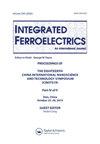二氧化锰掺杂在硼硅酸钙钠玻璃中的应用研究
IF 0.7
4区 工程技术
Q4 ENGINEERING, ELECTRICAL & ELECTRONIC
引用次数: 0
摘要
摘要本文研究了二氧化锰在硼硅酸钙钠(CNBS)玻璃中的掺杂。采用熔体淬火法制备了MnO2掺杂玻璃样品。对其结构、物理、光学和光致发光性能进行了测试和讨论。CNBS玻璃的x射线衍射光谱。没有尖锐的峰可以看到,表明玻璃的无定形性质。紫外-可见区的光学吸收在470 nm左右呈现出较宽的吸收带。随着MnO2浓度的增加,吸收光谱的强度带增大。测量了发光光谱,在417 nm激发下显示出强烈的黄色发射。结果表明,该玻璃可能适合于开发应用于黄色区域的光学材料。关键词:玻璃氧化锰发光硼硅酸盐披露声明作者未报告潜在利益冲突。本研究项目由泰国国家研究委员会(NRCT)资助(合同编号:N41A650403)和Gemories Thailand Company Limited。本文章由计算机程序翻译,如有差异,请以英文原文为准。
Investigation of Manganese Oxide (MnO 2 ) Doped in Calcium Sodium Borosilicate Glasses for Photonics Materials Application
AbstractIn this work, MnO2 doped in calcium sodium borosilicate (CNBS) glasses was investigated. The glass samples doped with MnO2 were synthesized by the melt quenching method. The structural, physical, optical, and photoluminescence properties were examined and discussed. The X-ray diffraction spectra of the CNBS glasses. There are no sharp peaks to be seen, indicating the amorphous nature of the glasses. The optical absorption in the UV–Vis region showed a broad absorption band around 470 nm. The intensity band of absorption spectra increases with increasing of MnO2 concentration. The luminescence spectra were measured and exhibited intense yellow emissions under 417 nm excitation. The results indicate that the glasses may be suitable for the development of optical material application in the yellow region.Keywords: Glassesmanganese oxideluminescenceborosilicate Disclosure StatementNo potential conflict of interest was reported by the author(s).Additional informationFundingThis research project is funded by National Research Council of Thailand (NRCT) (Contract No. N41A650403) and Gemories Thailand Company Limited.
求助全文
通过发布文献求助,成功后即可免费获取论文全文。
去求助
来源期刊

Integrated Ferroelectrics
工程技术-工程:电子与电气
CiteScore
1.40
自引率
0.00%
发文量
179
审稿时长
3 months
期刊介绍:
Integrated Ferroelectrics provides an international, interdisciplinary forum for electronic engineers and physicists as well as process and systems engineers, ceramicists, and chemists who are involved in research, design, development, manufacturing and utilization of integrated ferroelectric devices. Such devices unite ferroelectric films and semiconductor integrated circuit chips. The result is a new family of electronic devices, which combine the unique nonvolatile memory, pyroelectric, piezoelectric, photorefractive, radiation-hard, acoustic and/or dielectric properties of ferroelectric materials with the dynamic memory, logic and/or amplification properties and miniaturization and low-cost advantages of semiconductor i.c. technology.
 求助内容:
求助内容: 应助结果提醒方式:
应助结果提醒方式:


